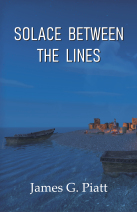
SOLACE BETWEEN THE LINES by James G. Piatt
James Piatt offers a bejeweled imaginary and yet simply real world in his poetry; the portion of a grander scene that many of his works convey, his detail of each scene reminds me of the scope Jean Paul Sartre, the existentialist author of Nausea and The Sleep among other works, brought to his novels. And so he contrasts in Hovel of Sand, the ”bloody sand, scarlet carpeting” under the soldiers knees with the “dull, adobe bricks” and the smell of the devil’s breath with “the acrid aroma of death” :
Amazon USAJames Piatt offers a bejeweled imaginary and yet simply real world in his poetry; the portion of a grander scene that many of his works convey, his detail of each scene reminds me of the scope Jean Paul Sartre, the existentialist author of Nausea and The Sleep among other works, brought to his novels. And so he contrasts in Hovel of Sand, the ”bloody sand, scarlet carpeting” under the soldiers knees with the “dull, adobe bricks” and the smell of the devil’s breath with “the acrid aroma of death” :
A shattered land of dead coral-lined seas;
With waves of crimson-splintered glass,
Gleaming like sharp, gaudy stones
Folded inside velvet sheaths of death:
The Ultra-Realism he engages in here, the color and texture we find, make up a part of Piatt’s sense of life’s tapestry of minute detail. He embraces every scene his work encounters with a vivid adoration of the essential ingredients of experience and complexity, rarely found in poetry or modern literature, so bent on expediency and brevity.
Piatt lingers for the time required to send visceral messages to all our emotions and connect them to a resounding overall realization that we too walked his way.
This poet does not engage his readers in long exhortation, but rather summarizes in a magical way the fullness of an otherwise lengthier engagement. In The Homeless Man we see :
Staircase that
Never goes up or down:
His life…
A minimalist painting,
A contemporary
Hodgepodge …
Of nothingness.
It is not so much the words he chooses but the fluid manner with which he passes from one unique panel to another. His choice of subject is like that of Rembrandt Van Rijn who knew the true dignity of his subjects lie in the intrinsic way we shared his experience of them, inclusive of all details required to make his point.
In Writing Poetry he asks :
below huge Sycamore trees in the silence of the coming twilight… I mused upon the strangeness of life and death, the absence of the past and present to come, and wondered
if the writing of poetry was nothing more than an absurd form of egotism which keeps an old man’s mind active for a short time.
He has answered that question himself when in Celestial Bandages he says :
then celestial
bandages are placed on all things
broken, causing a healing, a
rejuvenation, and a reason for joy
This is verse !
This work could only have been produced by a writer who spent time in the real world, in many places, for many a year. There is an overwhelming sense of sagacity in his manner and form of expression and I found I wanted more and more. This is a writer’s writer, whom I recommend heartily.
Review by Mary Barnet
Founder and Editor In Chief of PoetryMagazine.com
Critique: Haiku for the 21st Century : The Haiku of Sayumi Kamakura (Cyberwit. 2018),
At the Top : The Haiku and Poetry of Ban’ya Natsuishi (Cyberwit, 2019)
Poetry: The Train I Rode (Gilford Press, 2018),
Sonnets for Today’s Readers (Gilford Press, 2019)
